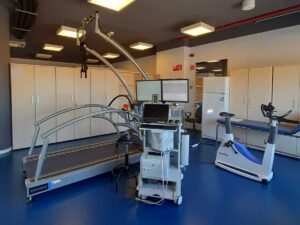Neuromuscular electrical stimulation (NMES) of the lower extremities elicits muscle contractions by activating efferent fibers and concomitant recruitment of afferent fibers, which can modulate central nervous system excitability. Electrostimulation (EMS) is a technique that activates the muscles individually and when used through a program of coordinated movement patterns of the extremities, it can guide cortical and spinal neuroplasticity in the central nervous system [2,3,4].
The effects of EMS on spinal reflexes applied unilaterally to unstimulated ipsilateral and contralateral muscles remains unknown. Therefore, the objectives of this study was to see how EMS applied to the plantar flexors (soleus) affects the excitability of the plantar flexors. The hypothesis was to see the effects of EMS applying it to the plantar flexors of the ankle, which provides a strong afferent input to the central nervous system, and to see how it affects the spinal reflexes of the ipsilateral muscles of the lower limbs but not the contralateral muscles.
12 healthy people participated in the study, during the study the participants remained in a supine position. Four different conditions were tested, each lasting 60 s:
1. EMS motor threshold: EMS was applied unilaterally in the right soleus with an intensity motor threshold. The EMS stimulus produced an isometric contraction of the plantar flexor without exerting any voluntary effort.
2. EMS sensitive threshold: EMS was applied unilaterally in the right soleus with a sensitive threshold of intensity. The EMS stimulus did not produce any isometric contraction of the plantar flexor.
3. Voluntary contraction: A voluntary isometric plantar flexor contraction was performed that was established at the same target force level as the threshold motor EMS.
4. Rest: The participants remained at rest during the evaluation.
For EMS, a Compex stimulator was used with a type of rectangular, biphasic, asymmetric wave with a pulse width of 300 µs and a frequency of 40 Hz.
In the results of this study, it was seen that 60 sg of EMS in one of the plantar flexors with a motor intensity threshold gave an inhibition of the spinal reflexes in the soleus muscle for at least 15 minutes after stimulation. Voluntary contraction in plantar flexion also caused an inhibition in spinal soleus reflexes but only for 5 minutes.
Analyzing this study we can reach the conclusion that the application of EMS for 60 s with a protocol of medium frequency (40 Hz), a pulse width of 300 µs and a motor threshold intensity can produce an inhibition in spinal reflexes during 15 minutes.This leads us to think that EMS can be a very useful tool to produce a reciprocal agonist-antagonist inhibition of ipsilateral muscles.
Bibliography:
- Matija Milosevic, Yohei Masugi, Hiroki Obata, Atsushi Sasaki, Milos R. Popovic, Kimitaka Nakazawa. (2019). Short-term inhibition of spinal reflexes in multiple lower limb muscles after neuromuscular electrical stimulation of ankle plantar flexors. Experimental Brain Research, 237, 467-476.
- Bergquist AJ, Clair JM, Lagerquist O, Mang CS, Okuma Y, Collins DF (2011) Neuromuscular electrical stimulation: implications of the electrically evoked sensory volley. Eur J Appl Physiol 111:2409–2426. https://doi.org/10.1007/s00421-011-2087-9.
- Milosevic M, Masani K, Popovic MR, Nakazawa K (2017) Neuro-physiological implications of functional electrical stimulation of muscles and nerves. Jpn J Biomech Sports Exerc 21:84–93
- Popovic MR, Curt A, Keller T, Dietz V (2001) Functional electrical stimulation for grasping and walking: indications and limitations. Spinal Cord 39:403–412. https://doi.org/10.1038/sj.sc.3101191







